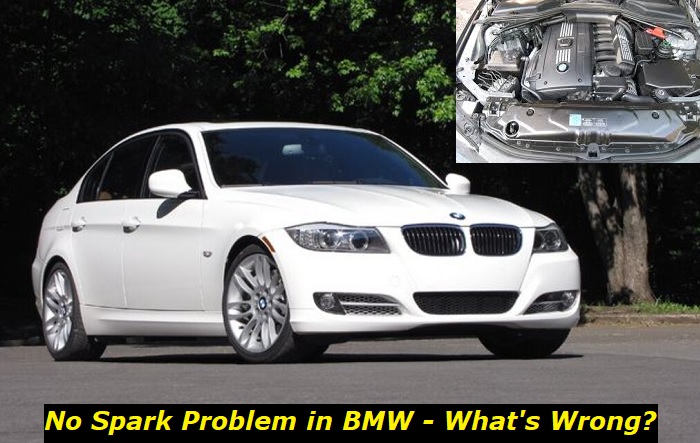Even while BMW remains one of the most distinguished brands in the market today, a BMW owner will encounter issues operating it. A BMW is a solid, reliable car that exudes class and elegance. However, the no-spark problem affects several drivers, and as a BMW owner, you should arm yourself with all the relevant information in case you encounter this issue.
No-start problems highlights
- DIY repairs:possible but complicated
- Tools needed:basictools set
- Commonreasons:battery issues, wiring problems, bad connections, electronic unit failure
- Time to repair:0.5 - 3 hours
- Price for parts:$100 - $450
- Can you drive?Obviously, no
- Alternative solutions:jump-starting, starter shorting, tow-truck

The BMW no-spark problem
The no-spark problem touches on the electrical part of the ignition. While looking for the cause, one should follow the electrical path that leads up to the production of a spark for ignition. To diagnose the problem correctly and be able to solve it effectively, you must be systematic. Below are the common problems to look out for and their solutions;
1) A dead battery
A dead battery is the most likely cause of a no-spark issue in your bimmer. Once the battery runs out of power, it cannot send the required voltage to the ignition coil. This then means the spark plug cannot send the required spark into the combustion chamber.
Solution
The answer to a dead battery is simply to replace it. Ensure you read your BMW's user manual to replace the correct battery. Your user manual also has a procedure you should follow when replacing the car battery. If the battery is working, then it's time to proceed to the next possible culprit - the spark plugs.
2) Faulty spark plugs
The spark plugs are allocated the exclusive role of igniting the air-fuel mixture in the combustion chamber once the right amount and pressure are achieved. When the pressure is insufficient, or the mixture's amount is not right, the spark plug will fail to ignite at the right time. This causes a misfire.
You need to conduct a simple test to check whether the spark plug is sending the required spark to the chamber. The test requires removing one spark plug and then plugging it back into its lead. Rest the spark plug on the metal of the engine, and don't touch it. Crank the engine and observe whether a thick blue spark is made at regular intervals. Of course, to observe this spark, a helper should be in the driver's seat to turn the engine on.
Solution
If it is diagnosed that the spark plug is the one causing the n-spark problem, the answer is to replace it. Spark plugs are best replaced as a set. If the problem is found to be faulty spark plugs, then you are lucky because the cost is considerably low. A functioning spark plug will throw a thick blue spark when the ignition is turned on. However, it is time to move on to the coil pack if there is no spark.
3) Faulty ignition coil
The ignition coil is a crucial part of the engine which powers the spark plug. The coil is connected to the distributor, which plays a crucial role in setting the combustion timing in the cylinders. For a millisecond, the ignition coil sends a high voltage to the spark plug at the precise moment when the air-fuel mixture is compressed to the maximum. The malfunctioning coil will not send the necessary high-voltage, which means no spark.
You may easily pinpoint an ignition coil problem if you notice some other symptoms associated with its failure. A faulty coil will throw the CEL warning. The engine can also stall and have numerous misfires. Of course, you will have noticed considerable power loss, lower fuel economy, and rough idling.
Solution
You should check the voltage in the coil using a voltmeter. If the voltage is not 12V, you have a coil issue in your hands, and you will need to replace the affected part. A coil is not expensive, and installing it is pretty straightforward. Once you have resolved the ignition coil problem and you are still experiencing no-spark, then it's time you check the ECU.
4) Blown ECU fuse and relay
The ECU -engine control unit of your bimmer is critical in the starting and running of the engine. Without the ECU, the engine of your luxury car will easily turn into a no-spark state. The ECU is the main computer of many of your engine components. As such, everything relies on the ECU. A faulty ECU can, for example, send more excessive gas to the chambers when you intend to slow down.
The malfunction of the ECU leads to poor fuel efficiency, misfiring, and the CEL will be illuminating on the dash. However, the biggest tell that the ECU has failed is a no-spark for the engine. Even if the engine starts, chances are that it will soon stall because the ECU will be unable to control the vehicle's computer.
A failed ECU can be tough to diagnose sometimes. Remember that the ECU is the component that records errors when parts such as ignition coils and spark plugs malfunction. If the ECU is completely dead, you might need the services of a BMW technician to diagnose the problem.
Solution
The answer to a faulty ECU is simply replacing it. There is nothing much that can be done as far as repair works go for this unit. However, before the mechanic recommends a replacement of the ECU, they should check the ECU fuse.
5) A blown ECU fuse
When you pop up the hood and open the fuse box, you should be able to locate the ECU fuse. This fuse is the link between the power supply and the ECU. If the fuse is blown, the ECU won't get power; consequently, there will be a no-spark situation. The fuse can be totally or partially blown. You should use a multimeter to confirm whether the fuse is blown. While checking the fuses, you should also check whether the wiring has an issue. In many instances where a fuse blows, a wiring problem tends to be the root cause.
Solution
A blown fuse is readily available, cheap, and easy to install. However, if the issue turns out to involve wiring, then you will need the services of an expert. Sometimes, a dying fuse will allow some power to reach the ECU, making the ECU show some dash lights and probably display some warning messages.
6) Bad crankshaft position sensor
The crankshaft positioning sensor is located near the crankshaft and will monitor the crankshaft's speed. When this sensor collects data on the position and the speed of the crankshaft, it sends it to the ECU. The ECU uses this information to know when to inject fuel and when to send the ignition spark through the spark plug. Indeed, it is a complex process where the crankshaft positioning sensor plays a central role.
A bad crankshaft positioning sensor will most likely cause a no-spark in your engine. Even if the spark is somehow sent and the engine starts, there will be many engine problems, and you will be forced to take your car to a mechanic immediately. When this sensor starts to malfunction, a trouble code will be sent, and the CEL will pop up on the dash. Another symptom to consider checking is if all four cylinders are misfiring randomly.
Solution
The crankshaft positioning sensor can malfunction if it is cracked due to the excess heat coming from the exhaust manifold. The plug may be loose, making the sensor work intermittently. Finally, the sensor could be clouded with metallic debris. Once you have confirmed none of these factors are causing the sensor to malfunction, replace it.
7) Engine not grounded
The other apparent cause for no-spark in bimmers, according to online bimmer owners and enthusiasts, is the lack of proper ground of the vehicle. When the engine is not properly ground, the DME will be unresponsive, and no matter how you try, there will be no spark. Just like is the case with home electronics, the battery power needs to be ground.
Solution
In many BMWs, the ground cable is found on the passenger side. When doing any wiring job on your BMW, it will be prudent to use a professional bimmer technician or be a professional. A bad ground increases resistance, hence heat, which can then cause a fire.
Conclusion
When your BMW has a no-spark problem, it is best to take a deep breath and start diagnosing the most obvious causes of the problem. If you were working on the vehicle's wiring, start by checking whether the ground cable is attached correctly. When the instrument cluster is flashing with warning lights, and nothing is happening when you start the engine, check the fuses to confirm that the ECU fuse is working. Gradually work your way to finding the cause of the no-spark issue.
About the authors
The CarAraC research team is composed of seasoned auto mechanics and automotive industry professionals, including individuals with advanced degrees and certifications in their field. Our team members boast prestigious credentials, reflecting their extensive knowledge and skills. These qualifications include: IMI: Institute of the Motor Industry, ASE-Certified Master Automobile Technicians; Coventry University, Graduate of MA in Automotive Journalism; Politecnico di Torino, Italy, MS Automotive Engineering; Ss. Cyril and Methodius University in Skopje, Mechanical University in Skopje; TOC Automotive College; DHA Suffa University, Department of Mechanical Engineering






Add comment